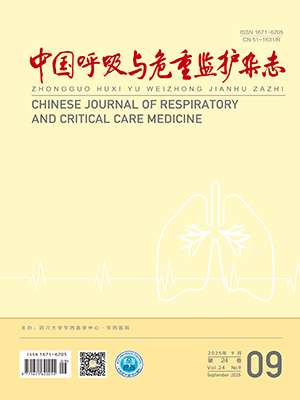| 1. |
Kariisa M, Foraker R, Pennell M, et al. Short- and long-term effects of ambient ozone and fine particulate matter on the respiratory health of chronic obstructive pulmonary disease subjects. Arch Environ Occup Health, 2015, 70(1): 56-62.
|
| 2. |
Guo C, Zhang Z, Lau AKH, et al. Effect of long-term exposure to fine particulate matter on lung function decline and risk of chronic obstructive pulmonary disease in Taiwan: a longitudinal, cohort study. Lancet Planet Health, 2018, 2(3): e114-e125.
|
| 3. |
Vrijens K, Bollati V, Nawrot TS. MicroRNAs as potential signatures of environmental exposure or effect: a systematic review. Environ Health Perspect, 2015, 123(5): 399-411.
|
| 4. |
Hou TF, Liao JP, Zhang C, et al. Elevated expression of miR-146, miR-139 and miR-340 involved in regulating Th1/Th2 balance with acute exposure of fine particulate matter in mice. Int Immunopharmacol, 2018, 54: 68-77.
|
| 5. |
Tantucci C, Modina D. Lung function decline in COPD. Int J Chron Obstruct Pulmon Dis, 2012, 7: 95-99.
|
| 6. |
Mannino DM, Davis KJ. Lung function decline and outcomes in an elderly population. Thorax, 2006, 61(6): 472-477.
|
| 7. |
Tálamo C, de Oca MM, Halbert R, et al. Diagnostic labeling of COPD in five Latin American cities. Chest, 2007, 131(1): 60-67.
|
| 8. |
IARC (2013) International Agency for Research on Cancer. Outdoor air pollution a leading environmental cause of cancer deaths. https://www.iarc.fr/wp-content/uploads/2018/07/pr221_E.pdf.
|
| 9. |
Zhao C, Liao J, Chu W, et al. Involvement of TLR2 and TLR4 and Th1/Th2 shift in inflammatory responses induced by fine ambient particulate matter in mice. Inhal Toxicol, 2012, 24(13): 918-927.
|
| 10. |
Bollati V, Marinelli B, Apostoli P, et al. Exposure to metal-rich particulate matter modifies the expression of candidate micro RNAs in peripheral blood leukocytes. Environ Health Perspect, 2010, 118(6): 763-768.
|
| 11. |
Li XB, Ding Z, Zhang CC, et al. MicroRNA-1228* inhibit apoptosis in A549 cells exposed to fine particulate matter. Environ Sci Pollut Res Int, 2016, 23(10): 10103-10113.
|
| 12. |
Qiao L, Cai J, Wang H, et al. PM2.5 constituents and hospital emergency-room visits in Shanghai, China. Environ Sci Technol, 2014, 48(17): 10406-10414.
|
| 13. |
Chuang KJ, Chan CC, Su TC, et al. The effect of urban air pollution on inflammation, oxidative stress, coagulation, and autonomic dysfunction in young adults. Am J Respir Crit Care Med, 2007, 176(4): 370-376.
|
| 14. |
Luo B, Liu J, Fei G, et al. Impact of probable interaction of low temperature and ambient fine particulate matter on the function of rats alveolar macrophages. Environ Toxicol Pharmacol, 2017, 49: 172-178.
|
| 15. |
Aztatzi-Aguilar OG, Uribe-Ramírez M, Narváez-Morales J, et al. Early kidney damage induced by subchronic exposure to PM2.5 in rats. Part Fibre Toxicol, 2016, 13(1): 68.
|
| 16. |
Kirenga BJ, Nantanda R, de Jong C, et al. Lung function of children at three sites of varying ambient air pollution levels in Uganda: a cross sectional comparative study. Int J Environ Res Public Health, 2018, 15(12): 2653.
|
| 17. |
Ogino K, Nagaoka K, Okuda T, et al. PM2.5-induced airway inflammation and hyperresponsiveness in NC/Nga mice. Environ Toxicol, 2017, 32(3): 1047-1054.
|
| 18. |
Sonkoly E, Pivarcsi A. Advances in microRNAs: implications for immunity and inflammatory diseases. J Cell Mol Med, 2009, 13(1): 24-38.
|
| 19. |
Deiters A. Small molecule modifiers of the microRNA and RNA interference pathway. AAPS J, 2010, 12(1): 51-60.
|
| 20. |
Plank M, Maltby S, Mattes J, et al. Targeting translational control as a novel way to treat inflammatory disease: the emerging role of microRNAs. Clin Exp Allergy, 2013, 43(9): 981-999.
|
| 21. |
Kapsogeorgou EK, Gourzi VC, Manoussakis MN, et al. Cellular microRNAs (miRNAs) and Sjogren's syndrome: candidate regulators of autoimmune response and autoantigen expression. J Autoimmun, 2011, 37(2): 129-135.
|
| 22. |
Tang Y, Luo X, Cui H, et al. MicroRNA-146a contributes to abnormal activation of the type I interferon pathway in human lupus by targeting the key signaling proteins. Arthritis Rheum, 2009, 60(4): 1065-1075.
|
| 23. |
Yamamoto M, Singh A, Sava F, et al. MicroRNA expression in response to controlled exposure to diesel exhaust: attenuation by the antioxidant N-acetylcysteine in a randomized crossover study. Environ Health Perspect, 2013, 121(6): 670-675.
|




